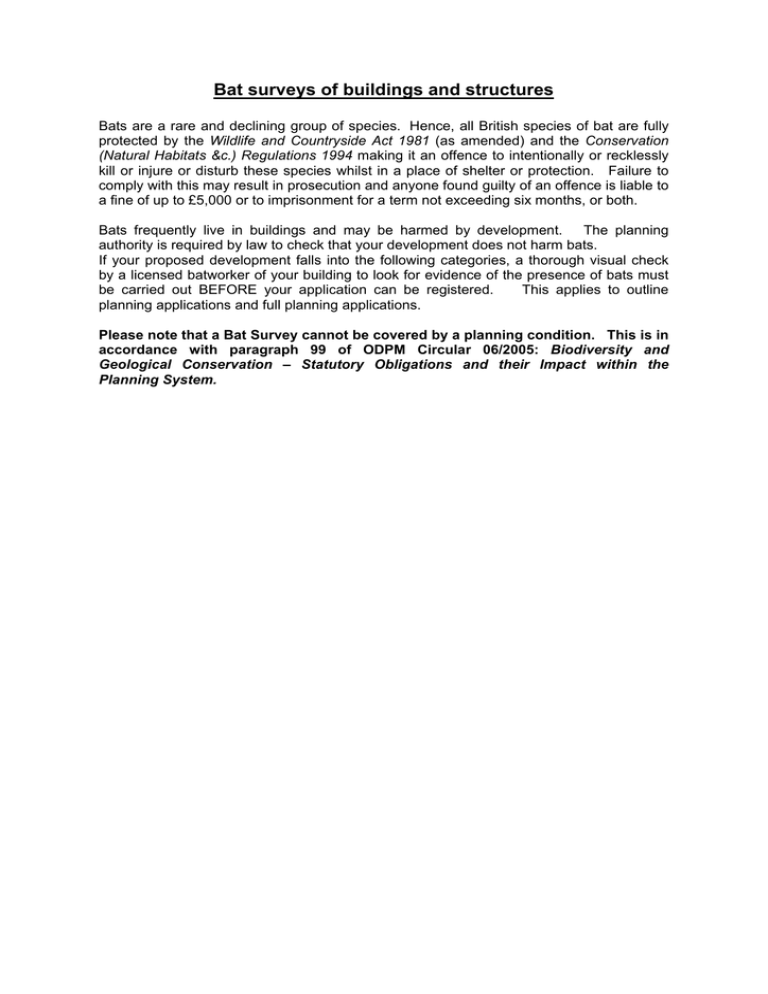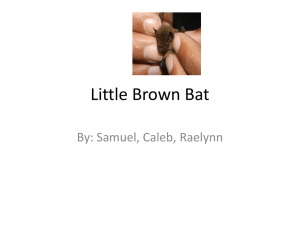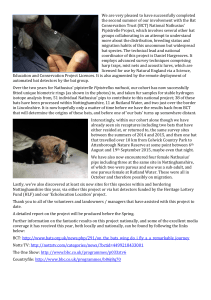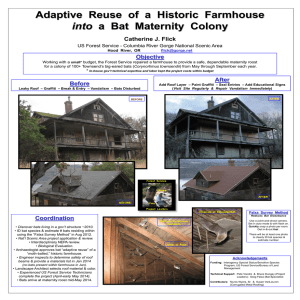Bat Surveys Of buildings And Structures
advertisement

Bat surveys of buildings and structures Bats are a rare and declining group of species. Hence, all British species of bat are fully protected by the Wildlife and Countryside Act 1981 (as amended) and the Conservation (Natural Habitats &c.) Regulations 1994 making it an offence to intentionally or recklessly kill or injure or disturb these species whilst in a place of shelter or protection. Failure to comply with this may result in prosecution and anyone found guilty of an offence is liable to a fine of up to £5,000 or to imprisonment for a term not exceeding six months, or both. Bats frequently live in buildings and may be harmed by development. The planning authority is required by law to check that your development does not harm bats. If your proposed development falls into the following categories, a thorough visual check by a licensed batworker of your building to look for evidence of the presence of bats must be carried out BEFORE your application can be registered. This applies to outline planning applications and full planning applications. Please note that a Bat Survey cannot be covered by a planning condition. This is in accordance with paragraph 99 of ODPM Circular 06/2005: Biodiversity and Geological Conservation – Statutory Obligations and their Impact within the Planning System. When is a bat survey needed to support a planning application? These criteria are considered by the planning authority and their ecology advisors when deciding if a bat survey is needed: Bats are more likely to found in these situations: Buildings, structures or sites that are adjacent or close to good bat foraging habitat or sites which contain these habitats. Good habitats include: Woodlands, scrubland and plantation; Mature trees and parkland Mature hedgerows Large gardens and allotments Lakes, reservoirs and large ponds; canals, rivers and large streams Types of development and buildings where a bat survey will usually be needed Any building or structure with an existing record for bats held by the Planning Authority, the Leicestershire and Rutland Environmental Records Centre, Natural England or the Leicestershire and Rutland Bat Group Demolition of a building or structure Renovation or conversion of a building with a roof, including derelict buildings Renovation, conversion or demolition of an agricultural building Conversion of house roofspace, including installation of roof lights or dormer windows House extensions that tie in to an existing enclosed roof space or affect any part of the roofline of the existing property Proposals to light churches; or green space close to good bat foraging habitats Proposals involving work to tunnels, mines, cellars or other underground structures Proposals for work to bridges and similar structures, especially over water/wet ground *Development where woodland, parkland or mature trees will be damaged or destroyed Bat surveys are NOT usually needed in the following circumstances Domestic garages and sheds with no enclosed roof space (i.e. with no ceiling) Modern flat-roofed buildings Metal framed and roofed buildings Buildings where the roofspace is already in regular use (such as an attic space converted to living space, or a living space open to the rafters) or where ALL the roofspace is lit from skylights or windows. Note that large and tall roofspaces may be dark enough at the apex to provide roost space for bats. * Note that bat surveys of trees are not covered by this protocol. Please refer to Bat Surveys: Good Practice Guidelines (2007) available from the Bat Conservation Trust, www.bats.org.uk What does a bat survey of a building or structure involve? The first step is a thorough visual check. This is an exhaustive internal and external inspection of the building to look for evidence of bats – such as bat droppings and roost entrance/exit holes. It is important that the bat worker has access to the roofspace and all parts of the building affected by the proposed development. This can be done at any time of the year, but should preferably be done when bats are active between May and midSeptember inclusive. The check MUST be done by a licensed bat worker. Leicestershire and Rutland Environmental Records Centre or Natural England can supply a list of consultants. 1. If no evidence of bats is found and building is of low risk of harbouring bats If the bat worker finds no evidence of bats following a thorough visual check, the Negative Bat Survey Statement (see Appendix 1) should be filled in and signed by the bat worker. The statement and visual check survey report must be submitted to the planning authority BEFORE your planning application can be registered. Please fill in a separate statement for each building/structure surveyed. If the bat worker considers that the building is of a low risk of harbouring bats, no further action is needed. Surveyors will need to demonstrate that thorough checks have been carried out 2. If no evidence of bats found, but building is of high or medium risk of harbouring bats The bat worker may not find any evidence of bats after a visual check, but considers that the building is of a high or medium risk of harbouring bats. Often this will be because the surveyor cannot get access to all the building, especially the roofspace. The surveyor might also feel that features are present which have a high to medium likelihood of harbouring bats, but which cannot be checked visually (e.g. soffits, cavity walls, the space between roof covering and roof lining). Pipistrelle Bats frequently roost in cavity walls and between roof covering and roof lining, for example, and do not usually enter roof voids. Evidence of their presence can be difficult to find when they are not active. Surveyors will need to demonstrate that that thorough checks have been carried out In these cases, further emergence surveys will be required before the application can be registered. Emergence surveys look for bats leaving the building at dusk and re-entering at dawn. They can only be carried out from May to mid-September, inclusive. They must be done by an experienced bat worker, and three surveys may be required during this period. Leicestershire and Rutland Environmental Records Centre or Natural England can supply a contact list. The need for emergence surveys may delay consideration of your application as they cannot be the subject of a planning condition. The completed survey report and either a Negative Bat Survey Statement OR a Bat Mitigation Plan (see Appendices 1 and 2) signed by the bat worker MUST be submitted to the planning authority BEFORE your planning application can be registered. Please fill in a separate plan or statement for each building/structure surveyed. 3. If evidence of bats is found If bats or evidence of bats is found, further emergence surveys will usually be needed. These can only take place from May to mid-September, inclusive. They must be done by an experienced bat worker, and three surveys may be required during this period. The surveys will inform a Bat Mitigation Plan (see Appendix 2), which must be filled in and signed by the applicant/agent. The Bat Mitigation Plan and the survey report must be submitted to the planning authority BEFORE your planning application can be registered. In a very few circumstances, there may not be any mitigation possible. In these situations, the development proposals is likely to be rejected. The Bat Mitigation Plan MUST be drawn up by a licensed bat worker and you must agree to follow it. Leicestershire and Rutland Environmental Records Centre or Natural England can supply a contact list of bat workers. The Bat Mitigation Plan will summarise the actions that will reduce the impact of your development on bats. This could include: timing of works, working methods and provision of permanent or temporary replacement bat roosts. This may require changes to the design of your development. The Bat Mitigation Plan will be referred to in a planning condition applied to your planning permission. Failure to follow the Bat Mitigation Plan or a planning condition may result in enforcement action against you. Your development may require a licence from Natural England before it can proceed; in addition to planning permission. Your bat worker will advise you. Please fill in a separate plan for each building/structure surveyed. How long is a bat survey valid for? Bat surveys that find evidence of bats are only valid for two survey seasons, or until another different application is made, whichever is the shorter period. A survey season is between May and mid-September, inclusive, so if an application is unchanged, a bat survey carried in June 2010 should be updated with emergence surveys from May to mid-September inclusive, in 2012. This is to see whether the bats have changed their roost location, or whether a new species has moved in, or whether numbers and types of roost has changed. Changed circumstances could require changes to mitigation. If the Bat Mitigation Plan is subject to a planning condition, changes must be approved in writing by the Planning Authority, backed up with a supporting survey report. If the type or scale of the proposed development changes, the mitigation needed might also change, therefore the Bat Mitigation Plan may need to be revised and re-submitted. Negative bat surveys carried out up to 2 years previously are valid in support of a planning application, and will last for the duration of the planning permission. As a visual bat check can be done at any time of year, a negative bat survey can be updated with a thorough visual check over winter; however it is preferable that it is done when bats are active during May to mid-September, inclusive. If evidence of bats is then found, an emergence survey will be required, to be carried out in the May to mid-September season, inclusive, following the visual check. If evidence is not found but the bat surveyor feels that there is a medium to high risk of bats being present, further emergence surveys will also be required. Leicestershire and Rutland Environmental Records Centre Holly Hayes 216 Birstall Road Leicester LE4 4DG 0116 267 1950 planningecology@leics.gov.uk August 2010 Appendix 1: Leicestershire and Rutland: Negative Bat Survey Statement Please fill in a separate statement for each building/structure surveyed. Continue on a separate sheet if necessary. Please attach a survey report/note setting out the methodology for the visual check. Please submit this form along with the planning application. Planning Authority: Grid reference: Planning application ref. no (if known): Planning application address: Proposed development: Building reference number (if applicable). If there are multiple buildings/structures, please attach a plan showing the layout of the site, and ensure that the buildings are numbered and referred to in this form. Name(s) and licence number(s)of Bat-worker(s) carrying out survey: Visual check/survey date(s): Brief description of building and roofspace: Describe any survey limitations – e.g. parts of roof or building that were inaccessible Do you consider the building to be of low/medium/high bat potential? Recommendation: Proceed with development with watching brief: Emergence survey needed: Other: Signed by bat worker(s): Date: Form created by Leicestershire and Rutland Environmental Records Centre, April 2010 Appendix 2: Leicestershire and Rutland Bat Mitigation Plan Please fill in a separate form for each building/structure surveyed. Continue on a separate sheet if necessary. Please attach a survey report setting out the methodology for the survey. Please submit this form along with the planning application. Section 1: Planning application and bat worker/survey details Planning application ref no (if Planning Authority: Grid reference: known): Planning application address: Proposed development: Building reference number (if applicable). If there are multiple buildings/structures, please attach a plan showing the layout of the site, and ensure that the buildings are numbered and referred to in this form. Name(s) and licence number(s)of bat-worker(s): Survey report reference and date: Section 2: Details of bat roosts (continue on separate sheet if necessary) Species A: (please give species name here) Type of roost (e.g. maternity, summer, winter) Estimated roost numbers: Location of roost in building (e.g. roof, crevice, timbers, cavity wall, between tiles/slates, under weatherboards, etc.). Describe, and show on map/diagram in Section 3. Dimensions of roost space (e.g. roof apex height, width and length) Roof aspect: N/S, E/W, SE/NW, SW/NE Species B: (please give species name here) Type of roost (e.g. maternity, summer, winter) Estimated roost numbers: Location of roost in building (e.g. roof, crevice, timbers, cavity wall, between tiles/slates, under weatherboards, etc.) Describe, and show on map/diagram in Section 3. Dimensions of roost space (e.g. roof apex height, width and length) Roof aspect: N/S, E/W, SE/NW, SW/NE Section 3: Details of Mitigation Roost replacement Permanent or temporary roost? Delete as necessary New roof void(s)? Y/N If Y, provide further details below Modified roof void(s)? Y/N If Y, provide further details below Bat box(es)? Y/N If Y, provide further details below Bat brick(s)? Y/N If Y, provide further details below Modified cavity wall box? Y/N If Y, provide further details below Modified roosts within walls/eaves Y/N If Y, provide further details below Further details of new/modified replacement roost in roof voids (if applicable): Width Height Length Location and aspect, including locations and types of roost entrance points Further details of Bat boxes/Bat bricks/modified roosts within walls/eaves or modified cavity wall box (if applicable): Make: Amount: Location and aspect Timing of works (month/year) – give calendar month and either give actual year or state whether action will occur in Year 1, Year 2, etc. of development Completion of temporary roost provisions (if applicable): Completion of permanent roost provisions (if applicable): Disturbance of existing roost and duration of disturbance: Other mitigation measures? We appreciate that the above mitigation measures are not comprehensive. If you have any other mitigation proposals, please provide details on a separate sheet or describe below Section 4: Building plan Provide a plan of the building and roofspace showing locations of: 1. Existing bat roosts and other features including entrance points 2. Permanent/temporary replacement bat roosts, bat boxes and bat bricks. If the replacement roost site is in a separate building or structure, please include a site plan showing its position in relation to existing roost site. Please provide a scale and a North arrow Section 5: Continuation sheets List continuation sheets, ensuring each one is signed and dated with address and building ref no. if applicable Section 6: Declaration (to be filled in by Bat Worker) I hereby confirm that the information in this Plan is correct, to the best of my knowledge: (print name) Date: (signature) Section 7 : Declaration (to be filled in by Applicant or Applicant’s Agent I hereby confirm that the measures set out in this Plan will be completed in full: Date: Applicant/Agent (delete as necessary) (print name) Applicant/Agent (delete as necessary) (signature) Form created by Leicestershire and Rutland Environmental Records Centre, April 2010





